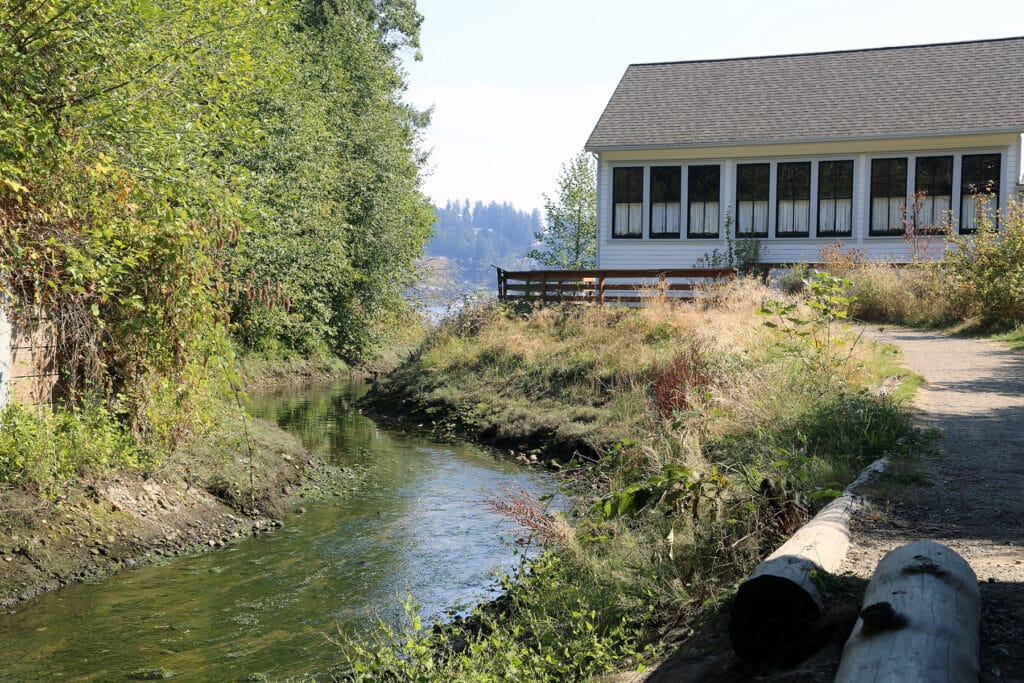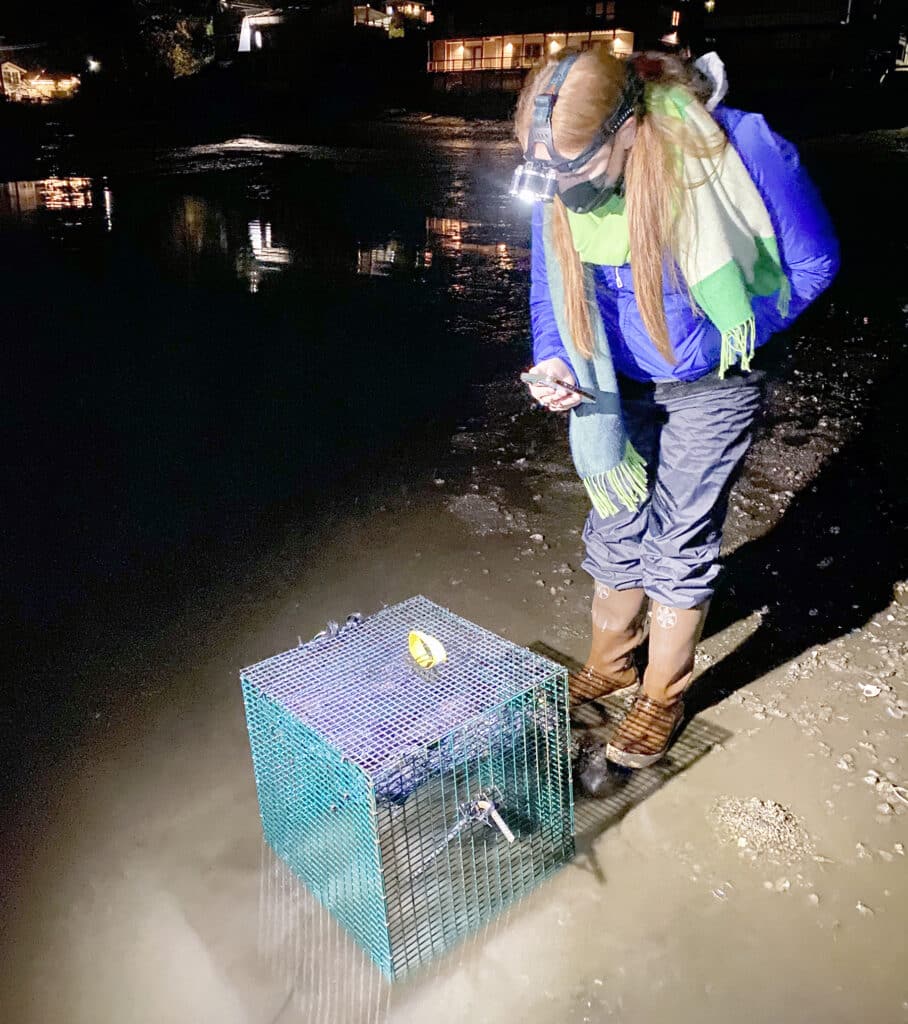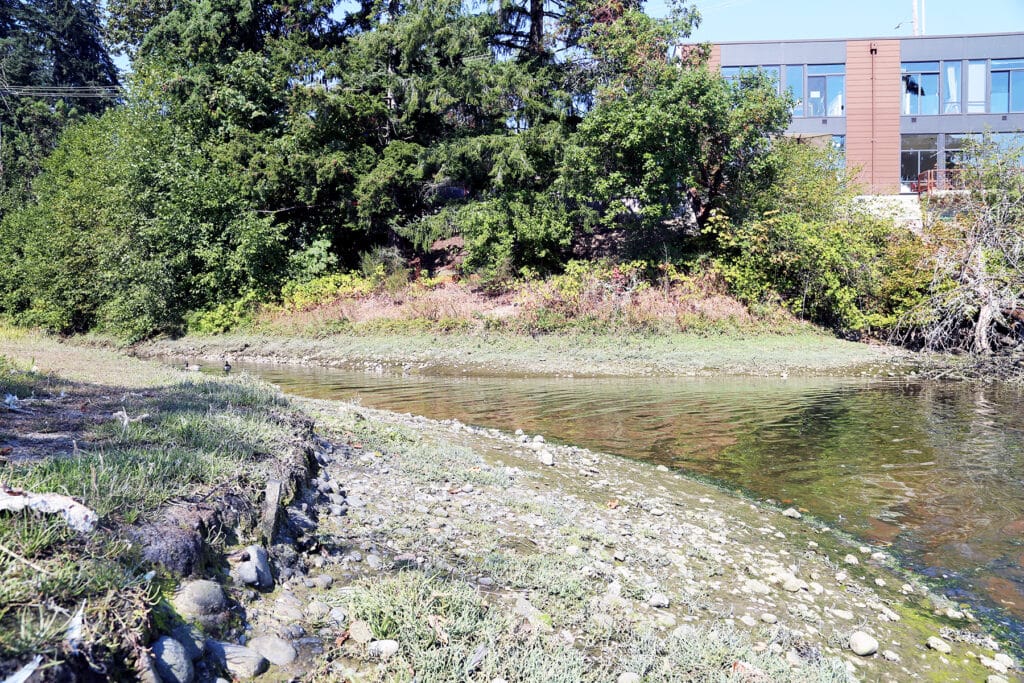Community Environment Government
Wait continues for new data on lead contamination near Donkey Creek
As the rocker Tom Petty told us, “The waiting is the hardest part.’’
A 20-year quest by state agencies to pinpoint the levels of toxic lead contamination of waters in and near Gig Harbor will continue for a while longer, as hiring slowly resumes at the Washington state Department of Ecology, and investigation and mitigation efforts inch forward.
Simultaneously, the Washington state Department of Fish and Wildlife says it has had to delay release of recent data on the levels of toxic lead in mussels.
Even as officials – and the public – await lead updates, Fish and Wildlife also reports very high levels of contamination in water from toxic polychlorinated biphenyls (PCBs) in Gig Harbor’s Donkey Creek delta. That’s the same spot where high levels of lead have been found in mussels since 2016. (More on PCBs anon.)

Donkey Creek flows into Gig Harbor Bay near the Harbor History Museum. Toxic lead has been detected in the area since 2002. Vince Dice
‘On-going issues’
Since 2002, toxic lead has been consistently detected in Gig Harbor’s Donkey Creek and North Creek, both endangered salmon-bearing streams. Neither creek is used for drinking water, but the city of Gig Harbor has hatched plans to remove culverts that pose obstacles to salmon and treat wastewater that washes contaminants into Gig Harbor Bay.
Mariko Langness, lead biologist of Fish and Wildlife’s Mussel Watch program, says that the department tests and monitors a variety of marine life, not just mussels. Among them are adult salmon and Pacific herring.
Fish and Wildlife also tests near-shore waters for contaminates from pharmaceuticals, personal care products, oil leaks and pesticides.
“We address changing conditions around Puget Sound. Gig Harbor has been done in three previous surveys: 2016, 2017 and 2020,’’ she says. “There have been on-going issues at the site,’’ she adds, referring to high lead toxicity found in the Donkey Creek delta.
“In the last three surveys with data available, the Donkey Creek site has consistently been one of the sites with high concentrations of lead observed at or above the 75th percentile for monitored sites,’’ Langness writes in an email to Gig Harbor Now.
“Also, when compared to relatively clean reference sites established in Hood Canal and Penn Cove (on the east side of) Whidbey Island, Donkey Creek concentrations were 3-5 times higher.’’
Planting mussels
Department staff and local volunteers gather mussels to test “near-shore areas inside and outside urban growth areas,’’ Langness says.
Fish and Wildlife teams plant the mussels in muddy, soggy spots like the Donkey Creek delta, where freshwater from the creek meets the saltwater of Gig Harbor Bay. The briny bivalves are later sent to Fish and Wildlife’s Olympia lab.
“The winter of 2021-2022 was the most recent survey,’’ Langness recounts. “We planted the mussels from October to January. Then we pulled up the mussels, cleaned them very thoroughly and extracted the soft tissue from the shell.’’

As part of Washington Department of Fish & Wildlife’s Mussel Watch program, mussels are planted in the delta of Donkey Creek. Tissue from the mussels is later tested for contaminants. Courtesy Harbor WildWatch
“We don’t do the chemical analysis,’’ Langness explains. “The National Oceanic and Atmospheric Administration laboratory in Seattle tests for organic contaminants. Lead testing is done by the Pierce County environmental lab. At that point, the timeline is in their hands.’’
“It takes us a long time,’’ she allows. “Covid shut down labs for a while. But we are managing to hire. We have been able to hire another research scientist.’’
Data possible by winter, at the earliest
That said, she doesn’t venture to pinpoint when the latest lead testing data will be released. Initial expectations were that preliminary data would be reported this summer, but Langness says, “Preliminary data from this survey will be available this winter at the earliest.’’
Stena Troyer, science specialist at Harbor WildWatch, leads the mussel survey in Gig Harbor. Troyer, who emphasizes that Harbor WildWatch partners closely with Fish and Wildlife’s Mariko Langness and Danielle Nordstrom, confirms that the 2022 data are not yet available to the Gig Harbor team.
The Washington state Department of Ecology started the 20-year lead hunt when it commissioned the Pierce County environmental lab to test Donkey Creek proper for lead in 2002. Ecology appears to be making some headway after a long period of stasis.
Sportsman’s Club has been cooperative
After attributing high levels of lead in Donkey Creek to the nearby Gig Harbor Sportsman’s Club, which uses lead ammunition at its shooting range on Burnham Drive, Ecology and the club agreed in November 2015 to come up with a clean-up plan.
Marian Abbett, Ecology’s supervisor of the department’s project manager for the site, said in February that the club had been cooperative.
Under then-club president Le Rodenberg, the club erected a 50-foot high, 500-foot wide thick fabric wall to block inadvertently errant shots around the shooting range. The club also took other steps to try to end the problem.
Yet since 2015, the Department of Ecology has not tested for lead in Donkey Creek. This resulted in a persistent data drought.
New site manager hired
Cheryl Ann Bishop, communications manager for Ecology’s Toxic Clean-Up Program, said this week that a new site manager has filled the long-vacant position.
Bishop adds that the Sportsman’s Club and its consultant, Philip Cordell of Farallon Consulting, “identified a data gap in the investigation results.’’ She says that a “data gap investigation has been partially implemented, including soil borings and testing, well installation and installation of a staff gauge and transduce.’’
Bishop says, moreover, that the new site manager will start reviewing those recent steps to see if the “clean-up can move to the next phase, which is a feasibility study.”
PCBs, aka forever chemicals
While all that is playing out, state and national officials are also calling for renewed attention to another persistent environmental problem – very high levels of toxic polychlorinated biphenyls (PCBs) in Washington waters, especially in Puget Sound.
PCBs, widely banned since the 1970s, are a class of oily chemicals once routinely used in industrial products. PCBs are so long-lasting, they are sometimes called forever chemicals.
People most at risk from PCBs are workers exposed to them on the job. Otherwise, the risk to humans comes from eating fish laced with the odorless, tasteless, nearly colorless chemicals, according to the Washington state Department of Health.
The U.S. Environmental Protection Agency also sounds the alarm about PCBs.
“Concerns remain high for the health of people who eat fish laden with PCBs, and experts warn that the entire Puget Sound food web remains at risk,’’ the EPA reported in 2017. The EPA classifies PCBs as probable human carcinogens and ties the chemicals to birth defects.
Those concerns have not gone away, either nationally or locally.
Highest concentration category at Donkey Creek
Writes Fish & Wildlife biologist Langness in an email: “We have seen consistently high concentrations of polychlorinated biphenyls. This contaminate is just as toxic as lead.’’
“The concentrations at the Donkey Creek site in all three surveys were in the highest concentration category (95th percentile), having the highest concentration of all the sampled sites in the south central basin, including Commencement Bay,’’ she revealed.

In addition to lead contamination, high concentrations of PCBs have also been found near the Donkey Creek delta. Vince Dice
James West, a senior scientist in the Marine Resources Division of Fish and Wildlife, points out that in Commencement Bay, bordering the Port of Tacoma, “it’s the industrial waterways, rather than the bay itself, that has very high levels of PCBs.”
How high? High enough that the Commencement Bay area is an EPA Superfund Site.
Why are PCB levels high in Gig Harbor?
As for Gig Harbor, West says: “I don’t know why the PCBs are high near Gig Harbor. I suspect it is related to a local, unknown industrial source. Sometimes culprits are leaking electrical transformers — the big ones on utility poles and at e-transfer stations. Most PCBs ever produced are still unaccounted for, meaning they are still in products or disposal areas, or whatever. We don’t know where it all is.’’
Unlike the slow-motion quest for documentation and mitigation for lethal lead, however, PCBs have drawn fire from the highest levels of the state’s executive branch.
Monsanto Co. — now part of the German giant Bayer AG — was the U.S. maker of PCBs since 1937. In June 2020, the company settled a PCB lawsuit brought by Washington state Attorney General Bob Ferguson. The company, without admitting guilt, agreed to pay $95 million for damage done to the state’s environment and economy.
In August, again without admitting guilt, Monsanto settled a combined $550 million class action PCB contamination lawsuit brought by 13 local governments nationwide, including the cities of Spokane and Tacoma. The class action settlement is scheduled to be finalized in December.
Given that PCBs can contaminate rivers, bays, lakes and creeks in waste water surges, wastewater treatment plans may figure into future cases. An on-deadline request to city of Gig Harbor wastewater technician Brianna Ellis for comment was not immediately returned in that tight time frame.
Reviewing years of incremental progress, thoughts drift back to Tom Petty’s lyric: The waiting is the hardest part/Every day you get one more yard.
